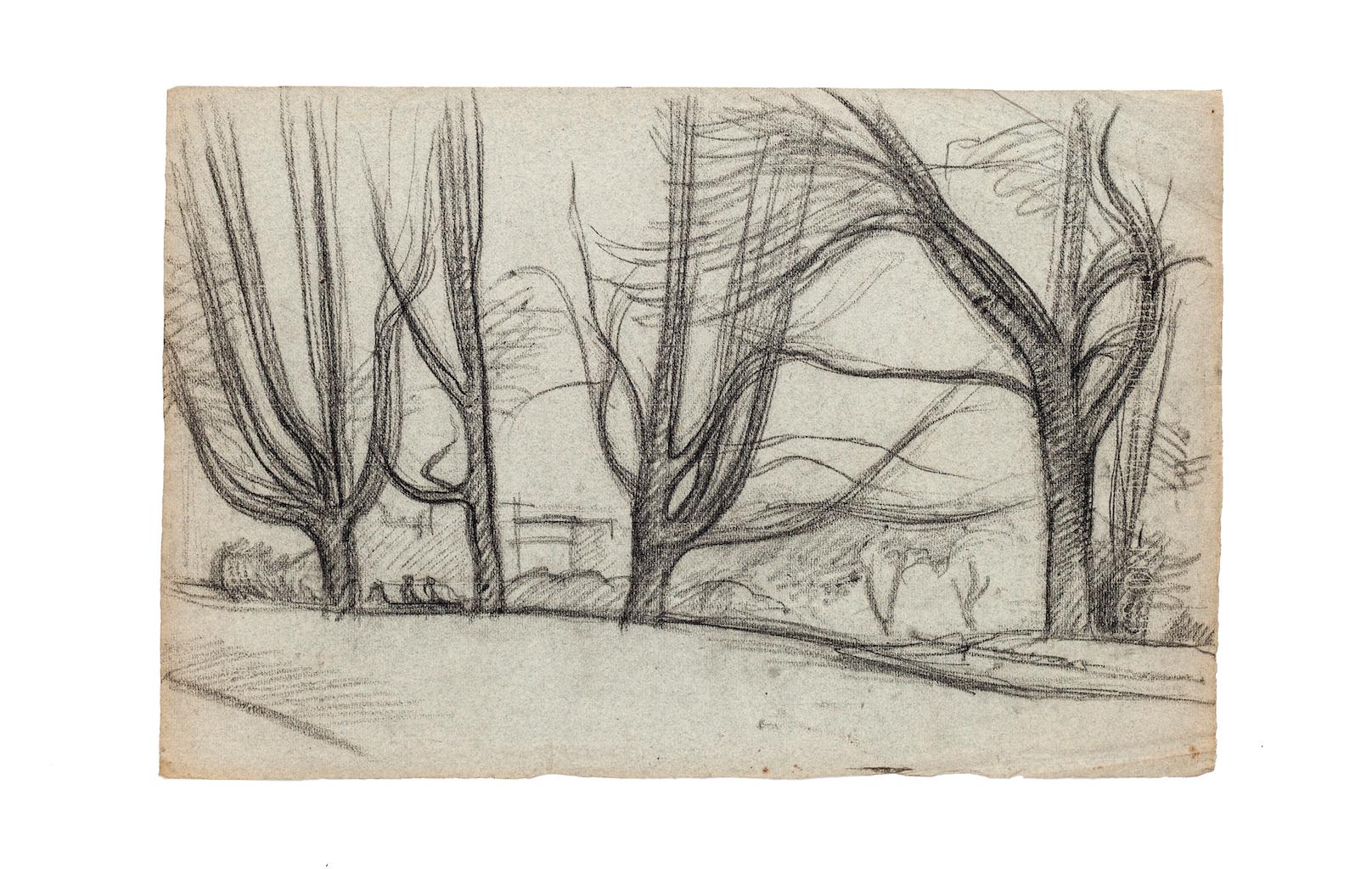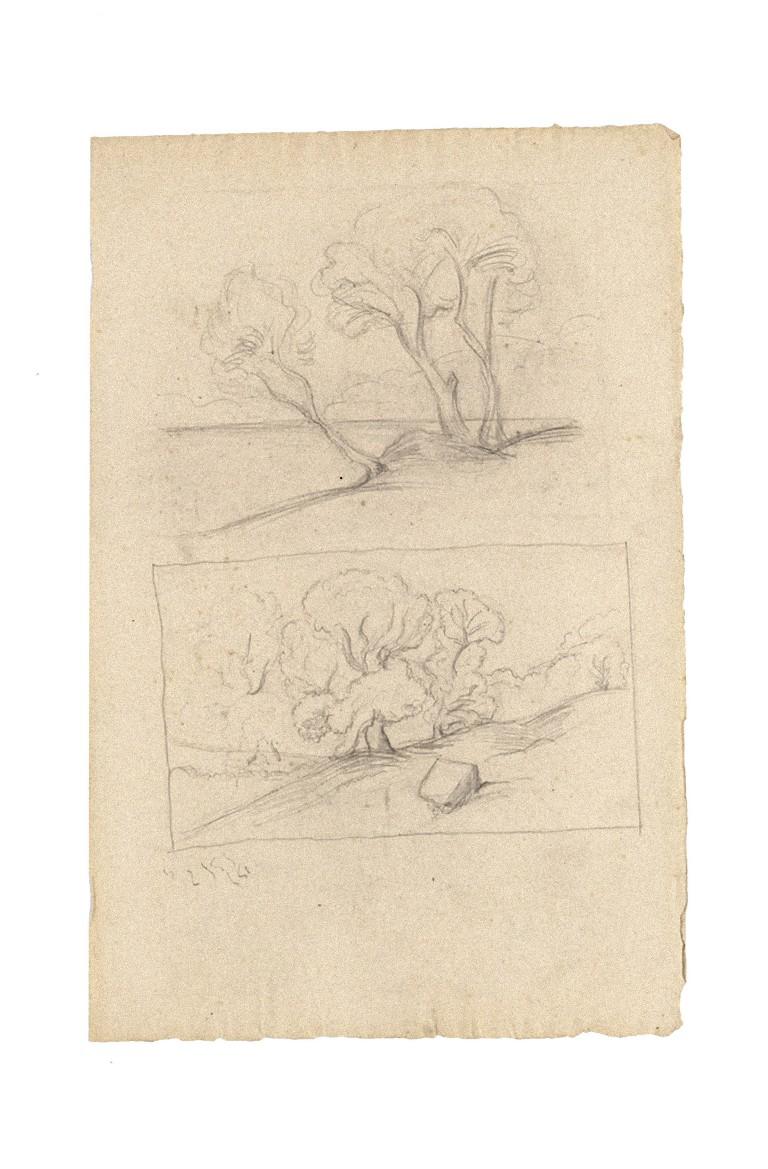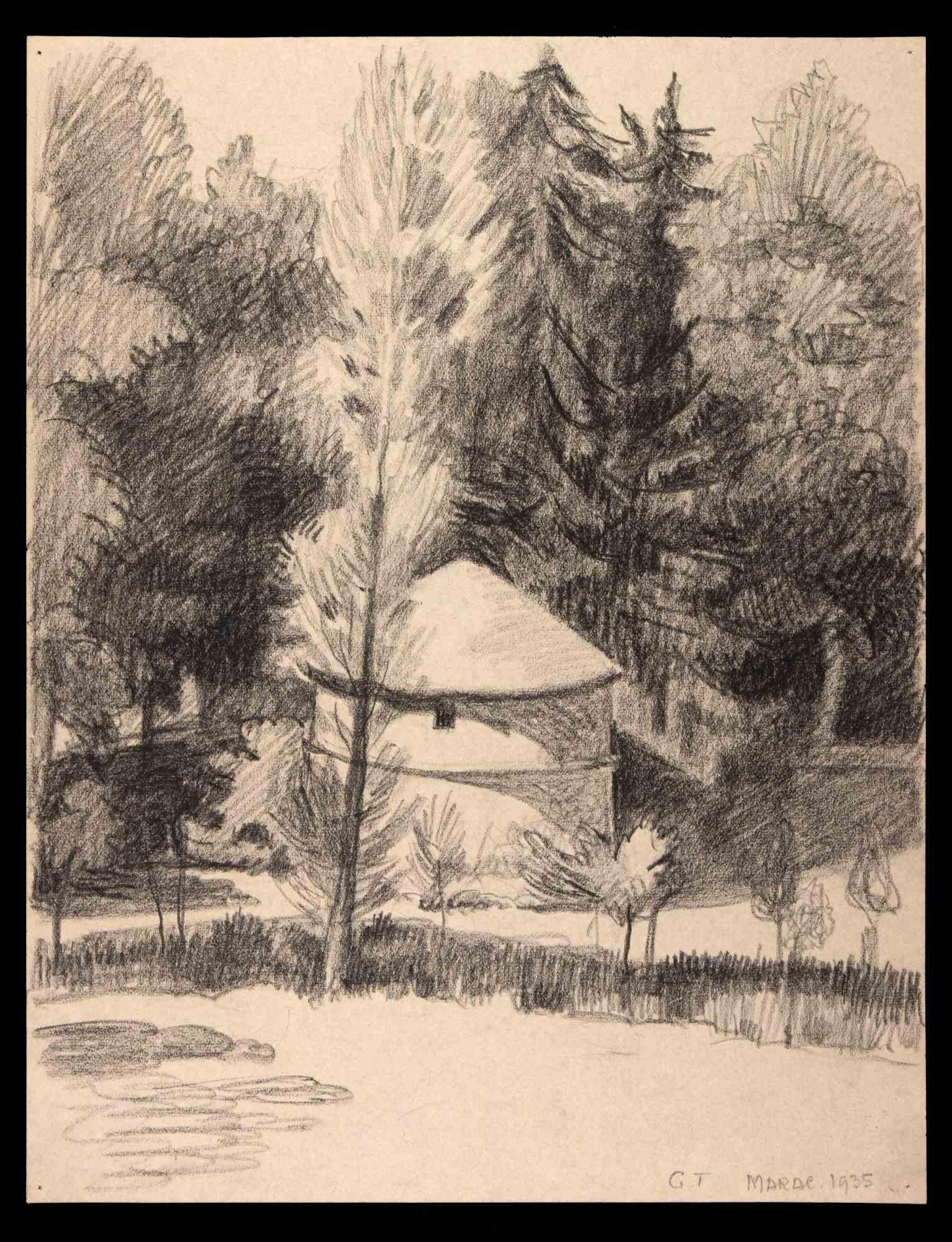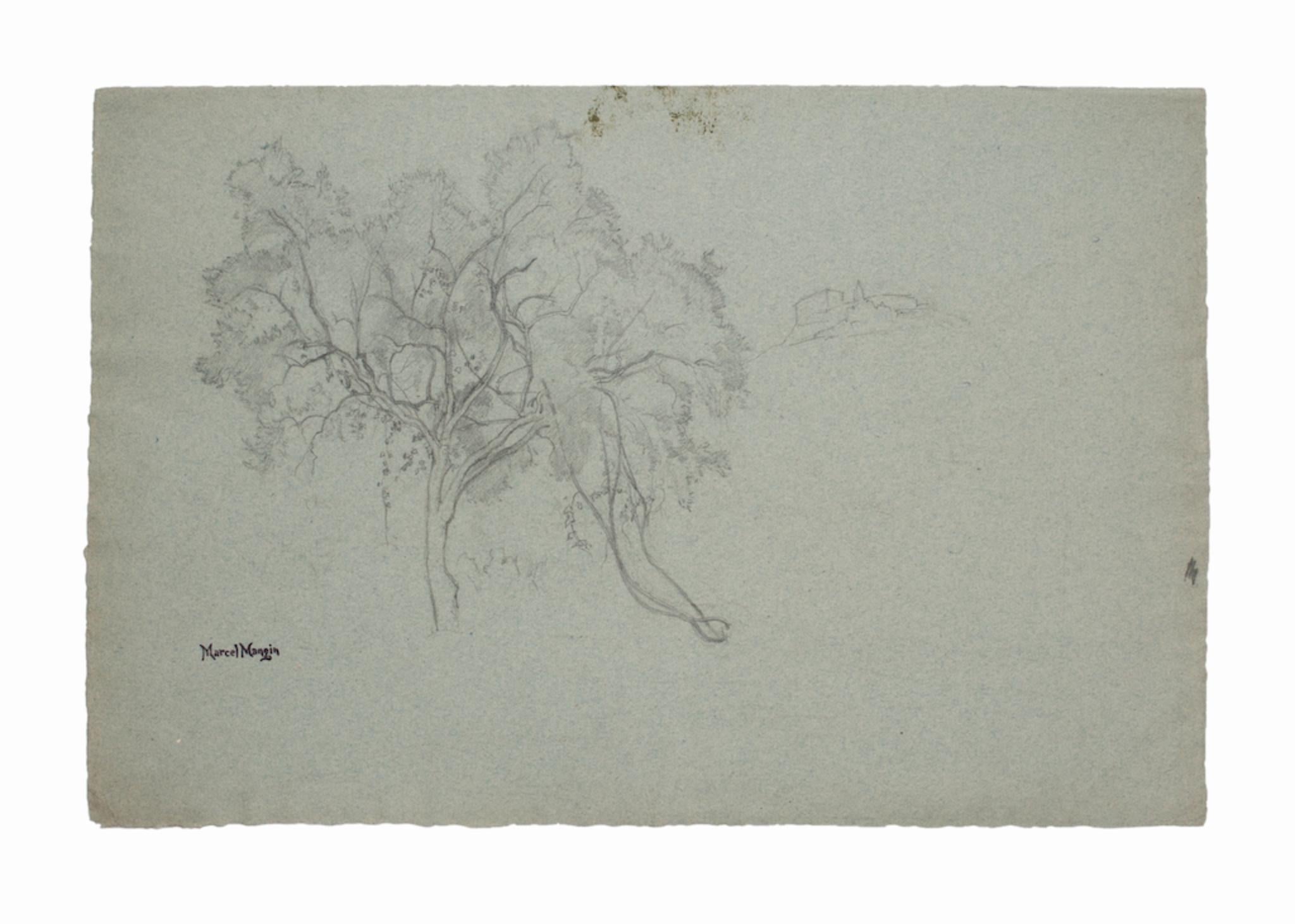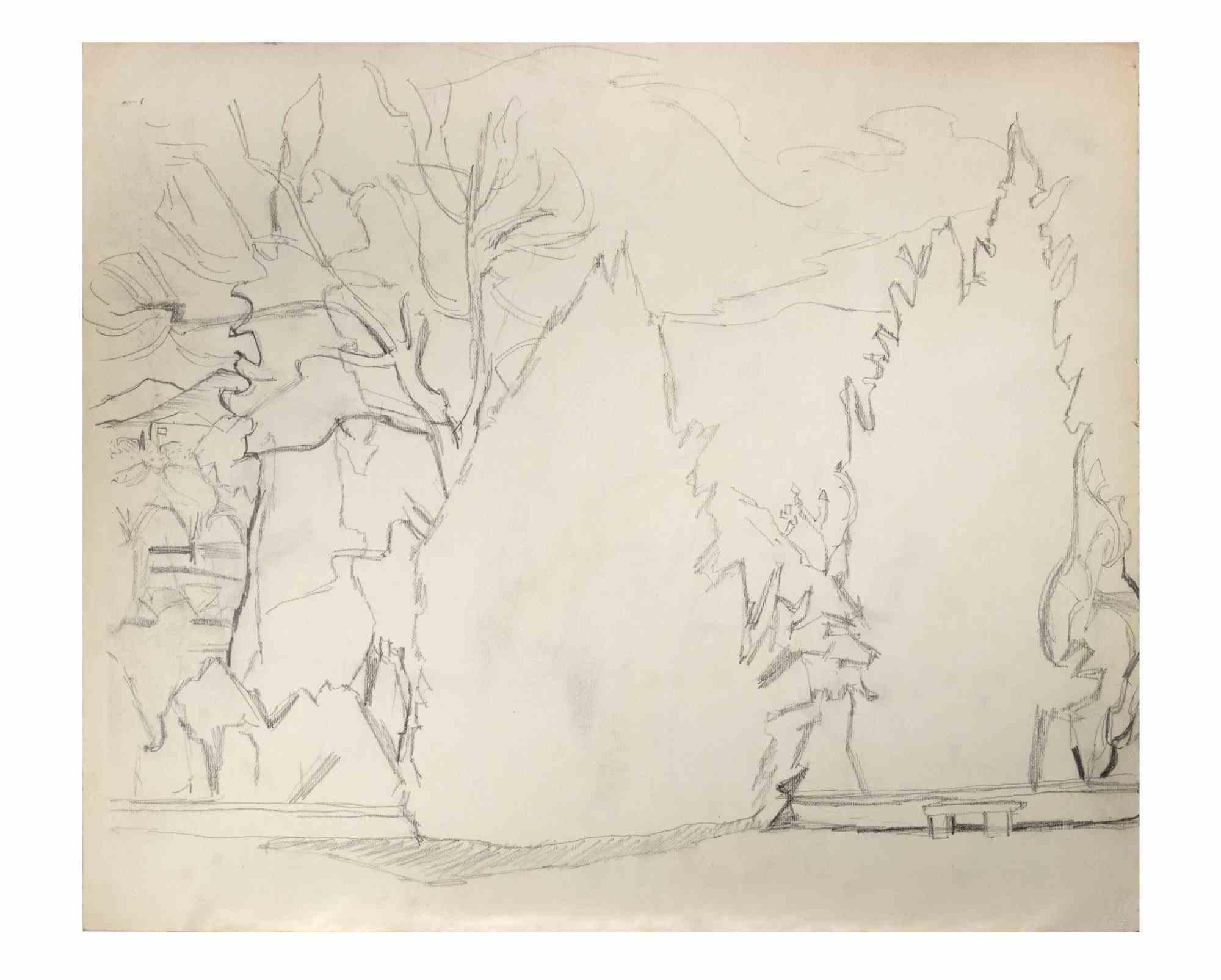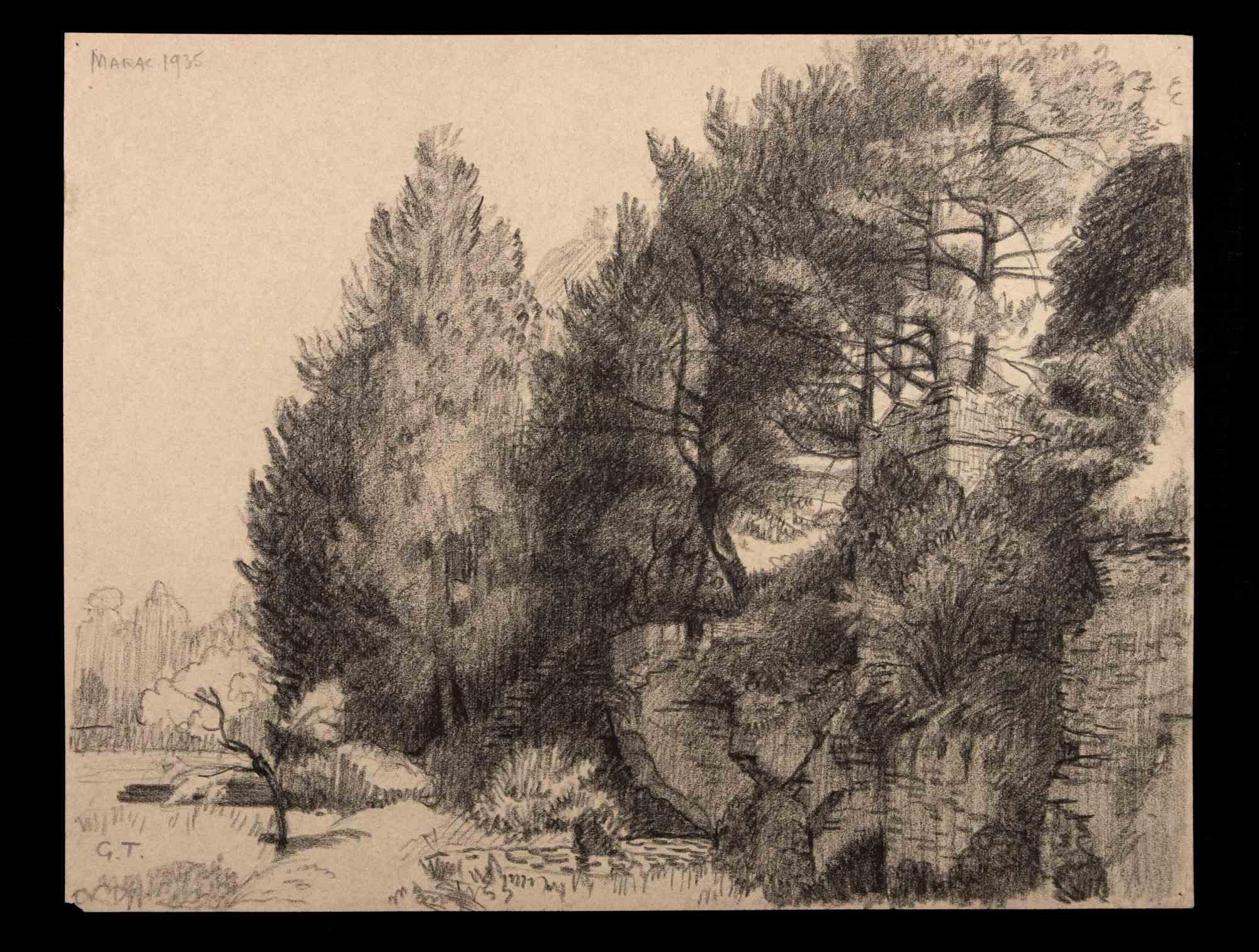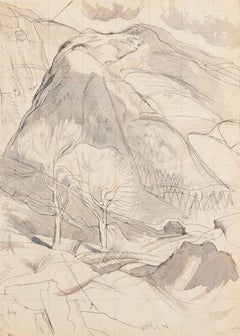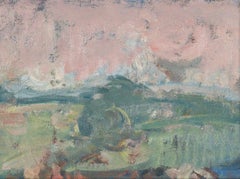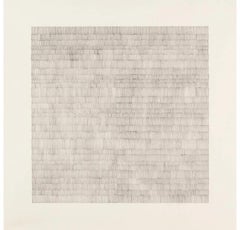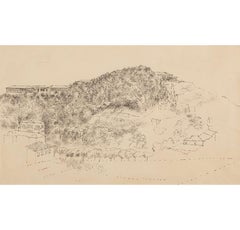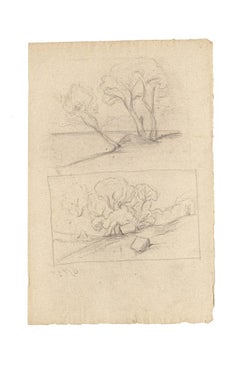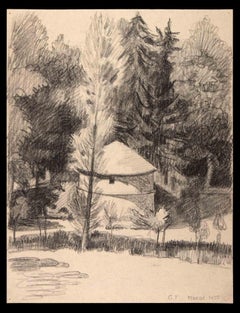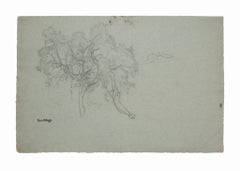Items Similar to Landscape with Trees, Pencil Drawing by Michael Andrews
Want more images or videos?
Request additional images or videos from the seller
1 of 3
UnknownLandscape with Trees, Pencil Drawing by Michael Andrews20th Century
20th Century
$3,104.23
£2,250
€2,654.28
CA$4,269.83
A$4,746.18
CHF 2,487.84
MX$57,962.31
NOK 31,059.30
SEK 29,221.01
DKK 19,810.76
About the Item
Landscape with Trees, Pencil Drawing by Michael Andrews
Additional information:
Medium: Pencil drawing
12.5 x 19.5 cm
4 7/8 x 7 5/8 in
Michael Andrews was born into a devout Methodist family. His father worked for Norwich Union insurance. He was educated at the City of Norwich School, and in his final year, attended evening classes at Norwich School of Art. After national service, much of it spent in Egypt, he studied at the Slade School of Fine Art in London. His main influences were William Coldstream, the Principal, and Francis Bacon, who occasionally taught in the school's sketching club. In 1953, he won a two-year scholarship in painting to the British School at Rome. Upon his return from Rome, he divided his time between Norwich and London before settling in London in 1961. He remained there until 1977, when he moved to Norfolk. His first solo exhibition was held at the Beaux Arts Gallery in London in 1958, and his second at the same venue in 1963, the year he started living with June Keeley, his future wife. They had one daughter, Melanie, born in 1970. In 1992, they returned from Norfolk to London where Andrews died three years later. During his lifetime, he was given a retrospective at the Hayward Gallery, London (1980-81). Another was held after his death at Tate Britain, London (2001).
Andrews is usually associated with painters of the so-called School of London-Francis Bacon, Lucian Freud, Leon Kossoff and Frank Auerbach. Yet in spite of their shared belief in representing appearances, exploring the human form, and avoiding abstraction, he painted relatively few portraits and only three self-portraits in a career lasting some forty years. With a few exceptions, his paintings after 1970 are physically devoid of people, though not without an implied human presence or drama.
For the last twenty-five years of his life, Andrews was preoccupied with four great series of landscapes, and a group of luminous paintings of fish in water. The latter continue Andrews's interest in group behaviour, first seen in the 1960s in his "party" pictures, The Deer Park, All Night Long, and Good and Bad at Games. Intensely curious about the natural world, Andrews found his subjects in the primeval landscapes of England and Scotland, the Australian outback, and the River Thames. "It seems to me impossible not to paint religious landscapes of aboriginal Australia," he wrote in 1986, "just as it is almost impossible not to paint historical landscapes in Scotland."
Michael Andrews was born in 1928 in Norwich, England, and died in 1995 in London, England. He attended the City of Norwich School, England; Norwich School of Art, England; and finally the Slade School of Fine Art, London, from 1949 to 1953. Recent solo museum exhibitions include the Scottish National Gallery of Modern Art, Edinburgh (1991); Museo Thyssen-Bornemisza, Madrid (2000); and Tate Britain, London (2001).
- Creation Year:20th Century
- Dimensions:Height: 4.875 in (12.39 cm)Width: 7.625 in (19.37 cm)
- Medium:
- Period:
- Condition:
- Gallery Location:Kingsclere, GB
- Reference Number:1stDibs: LU2718214572892
About the Seller
No Reviews Yet
Vetted Professional Seller
Every seller passes strict standards for authenticity and reliability
Established in 2010
1stDibs seller since 2024
41 sales on 1stDibs
Typical response time: 7 hours
- ShippingRetrieving quote...Shipping from: Kingsclere, United Kingdom
- Return Policy
Authenticity Guarantee
In the unlikely event there’s an issue with an item’s authenticity, contact us within 1 year for a full refund. DetailsMoney-Back Guarantee
If your item is not as described, is damaged in transit, or does not arrive, contact us within 7 days for a full refund. Details24-Hour Cancellation
You have a 24-hour grace period in which to reconsider your purchase, with no questions asked.Vetted Professional Sellers
Our world-class sellers must adhere to strict standards for service and quality, maintaining the integrity of our listings.Price-Match Guarantee
If you find that a seller listed the same item for a lower price elsewhere, we’ll match it.Trusted Global Delivery
Our best-in-class carrier network provides specialized shipping options worldwide, including custom delivery.More From This Seller
View AllMountain Landscape, Pen and Ink Drawing by John Nash, 1950s, Double-sided
By John Nash
Located in Kingsclere, GB
Mountain Landscape, Pen and Ink Painting by John Nash 1893-1977, circa 1950
Additional information:
Medium: Pen and ink, with another pen and ink with watercolour verso
29 x 21 cm
1...
Category
20th Century Landscape Paintings
Materials
Pen
Landscape with Trees Painting by Martin Yeoman, 2023
By Martin Yeoman
Located in Kingsclere, GB
Landscape with Trees Painting by Martin Yeoman B. 1953, 2023
Additional information:
Medium: Oil on board
Dimensions: 13.5 x 21.5 cm
5 1/4 x 8 1/2 in
Martin Yeoman was born in 1953...
Category
21st Century and Contemporary Abstract Paintings
Materials
Board
Untitled IV, Pencil on Paper Drawing by Jon Probert, 2023
By Jon Probert
Located in Kingsclere, GB
Untitled IV, Pencil on Paper Drawing by Jon Probert B. 1966, 2023
Additional information:
Medium: Pencil on paper
Dimensions: 40 x 40 cm
15 3/4 x 15 3/4 in
Signed and dated
Having ...
Category
21st Century and Contemporary Abstract Drawings and Watercolors
Materials
Paper
Italian Landscape, Pen Painting by Reginald Brill, 1950 circa
By Reginald Brill
Located in Kingsclere, GB
Italian Landscape, Pen Painting by Reginald Brill, 1950 circa
Additional information:
Medium: Ink
20 x 34 cm
7 7/8 x 13 3/8 in
Reginald " Reggie" Brill was a versastile 20th century artist and teacher.
Brill was born in London in 1902 and spent his early childhood there and in Yorkshire. By the time of the First World War, at the age of 13, he was living in lodgings in London, working in a City office and attending St Martins School of Art in the evenings. Considering his lack of education, winning a scholarship to The Slade (now part of University College London) in 1921 where he studied under Henry Tonks for three years, was a huge achievement.
On leaving The Slade he found patronage in Lincolnshire, but by the time of the General Strike (1926) he had returned to London and was working on Lansbury's Labour Weekly. He married Rosalie, also an artist, and in 1927 won the Prix de Rome in Decorative Painting. Following two years at The British School in Rome, Brill went to teach at Blackheath School of Art. During 1930 he spent three months painting in Egypt and it was there that he met Col. T G Gayer-Anderson, one of the twin brothers who were to bequeath The Little Hall in Lavenham as a hostel for art students. It was there that Brill retired to act as warden, thus continuing his nurturing of art students until his death in 1972.
Brill took up his appointment at The School of Art, Kingston upon Thames in January 1934. It was situated in the Technical Institute (Kingston Hall Road) and Brill found it bohemian and disorganised. He proceeded to inject enthusiasm, order and discipline. Within 5 years of his appointment a purpose-built School of Art was opened in Knights Park. It remained open throughout the war and by 1945 there was a waiting list for places. Under the skilled and totally dedicated direction of Brill, Kingston School of Art became established with national reputation for excellence. In 1961 Sir Charles Wheeler opened the new building at Knights Park. Costing £100,000, this more than doubled the size of the Art School.
Brill, was a well-known figure in Kingston. His eloquence made him popular as a guest speaker and his promotion of Art and Design stretched well beyond the doors of Knights Park. Apart from establishing two of the main buildings which makeup what is now known as the Faculty of Design, one of the most visible local contributions he made was the setting up of a topographical collection of paintings depicting Kingston, which has since become known as The Brill Collection at Kingston Museum. Brill gained huge respect and admiration from the hundreds of pupils who studied at Kingston during his 30-year leadership.
He published two books, Modern Painting 1946 and Art as a Career 1962, both bearing a strong educational angle. He regularly exhibited along with leading artists of his era at The Royal Academy, both his paintings and his acutely observed drawings. All the while he was a prolific artist, although reading his diaries, intensely self-critical. His perfectionism, acute powers of observation and relentless research can be seen in his drawings, which via the media and methods he explored throughout his life reflect mid 20th century British Art at its most typical. His major series of work, known as 'The Martyrdom of Man', was carried on in parallel to his career as a teacher. These paintings reflect his care for fellow man and depict people at work, e.g., The Operation, The Jury, Linemen, Waiting Room and Rest, which recently sold at Sotheby’s and was specially restored for The Brill Retrospective. His smaller works also play with the theme of everyday events and communication amongst people, such as The Bull Ring and Market Place paintings.
Brill's name is associated particularly with human figure compositions, but he also worked on landscapes, portraits and details of plants, animals, interiors etc. As one would expect he moved from one media to another, and his unusual hand painted and cut paper mosaics...
Category
20th Century Landscape Paintings
Materials
Pen
The Industrial Landscape as it Passes By (From the Train) by Mary Newcomb
By Mary Newcomb
Located in Kingsclere, GB
The Industrial Landscape as it Passes By (From the Train), Pencil Drawing by Mary Newcomb 1922-2008
Additional information:
Medium: Pencil
13.3 x 20.6 c...
Category
20th Century Landscape Drawings and Watercolors
Materials
Pencil
Italian Scene, Pen and Ink with Wash Painting by Reginald Brill, 1950s circa
By Reginald Brill
Located in Kingsclere, GB
Italian Scene, Pen and Ink with Wash Painting by Reginald Brill, 1950s circa
Additional information:
Medium: Pen and ink with wash
33 x 48.3 cm
13 x 19 in
Reginald " Reggie" Brill was a versastile 20th century artist and teacher.
Brill was born in London in 1902 and spent his early childhood there and in Yorkshire. By the time of the First World War, at the age of 13, he was living in lodgings in London, working in a City office and attending St Martins School of Art in the evenings. Considering his lack of education, winning a scholarship to The Slade (now part of University College London) in 1921 where he studied under Henry Tonks for three years, was a huge achievement.
On leaving The Slade he found patronage in Lincolnshire, but by the time of the General Strike (1926) he had returned to London and was working on Lansbury's Labour Weekly. He married Rosalie, also an artist, and in 1927 won the Prix de Rome in Decorative Painting. Following two years at The British School in Rome, Brill went to teach at Blackheath School of Art. During 1930 he spent three months painting in Egypt and it was there that he met Col. T G Gayer-Anderson, one of the twin brothers who were to bequeath The Little Hall in Lavenham as a hostel for art students. It was there that Brill retired to act as warden, thus continuing his nurturing of art students until his death in 1972.
Brill took up his appointment at The School of Art, Kingston upon Thames in January 1934. It was situated in the Technical Institute (Kingston Hall Road) and Brill found it bohemian and disorganised. He proceeded to inject enthusiasm, order and discipline. Within 5 years of his appointment a purpose-built School of Art was opened in Knights Park. It remained open throughout the war and by 1945 there was a waiting list for places. Under the skilled and totally dedicated direction of Brill, Kingston School of Art became established with national reputation for excellence. In 1961 Sir Charles Wheeler opened the new building at Knights Park. Costing £100,000, this more than doubled the size of the Art School.
Brill, was a well-known figure in Kingston. His eloquence made him popular as a guest speaker and his promotion of Art and Design stretched well beyond the doors of Knights Park. Apart from establishing two of the main buildings which makeup what is now known as the Faculty of Design, one of the most visible local contributions he made was the setting up of a topographical collection of paintings depicting Kingston, which has since become known as The Brill Collection at Kingston Museum. Brill gained huge respect and admiration from the hundreds of pupils who studied at Kingston during his 30-year leadership.
He published two books, Modern Painting 1946 and Art as a Career 1962, both bearing a strong educational angle. He regularly exhibited along with leading artists of his era at The Royal Academy, both his paintings and his acutely observed drawings. All the while he was a prolific artist, although reading his diaries, intensely self-critical. His perfectionism, acute powers of observation and relentless research can be seen in his drawings, which via the media and methods he explored throughout his life reflect mid 20th century British Art at its most typical. His major series of work, known as 'The Martyrdom of Man', was carried on in parallel to his career as a teacher. These paintings reflect his care for fellow man and depict people at work, e.g., The Operation, The Jury, Linemen, Waiting Room and Rest, which recently sold at Sotheby’s and was specially restored for The Brill Retrospective. His smaller works also play with the theme of everyday events and communication amongst people, such as The Bull Ring and Market Place paintings.
Brill's name is associated particularly with human figure compositions, but he also worked on landscapes, portraits and details of plants, animals, interiors etc. As one would expect he moved from one media to another, and his unusual hand painted and cut paper mosaics...
Category
20th Century Landscape Paintings
Materials
Pen
You May Also Like
Trees - Original Drawing in Pencil and Charcoal - 20th Century
Located in Roma, IT
Trees is an original drawing in pencil and charcoal, realized by an Anonymous artist of the XX century.
The state of preservation of the artwork is very good and aged with some fold...
Category
20th Century Modern Figurative Drawings and Watercolors
Materials
Charcoal, Pencil
Landscape - Original Drawing in Pencil on Paper - 20th Century
Located in Roma, IT
Landscape is an original drawing in pencil on paper realized by an Anonymous artist of the XX century. With the drawing of the trees on the rear.
The State of preservation is very g...
Category
20th Century Modern Figurative Drawings and Watercolors
Materials
Pencil
Landscape with Trees - Original Drawing by George-Henri Tribout - 1935
By Georges-Henri Tribout
Located in Roma, IT
Landscape with Trees is an original artwork realized by Georges Henri Tribout in 1935 in Marac. Pencil Drawing, hand signed on the lower right margin and dated "Marac 1935".
Good Co...
Category
1930s Modern Landscape Drawings and Watercolors
Materials
Paper, Pencil
Trees - Original Pencil Drawing by Marcel Mangin - Mid-20th Century
By Marcel Mangin 1
Located in Roma, IT
Trees is an original drawing in pencil on paper by Marcel Mangin.
In good conditions
This is an original drawing representing beautiful trees.
Signed ...
Category
20th Century Contemporary Figurative Drawings and Watercolors
Materials
Pencil
Landscape - Drawing By Reynold Arnould - Mid-20th century
Located in Roma, IT
Landscape is a pencil drawing realized by Reynold Arnould (Le Havre 1919 - Parigi 1980).
Good condition.
No signature.
Reynold Arnould was born in Le Havre, France in 1919. He s...
Category
Mid-20th Century Modern Landscape Drawings and Watercolors
Materials
Paper, Pencil
Landscape with Trees - Original Drawing by George-Henri Tribout - 1940
By Georges-Henri Tribout
Located in Roma, IT
Landscape with Trees is an original artwork realized by Georges Henri Tribout in 1935 in Marac. Pencil Drawing, hand signed on the lower margin left and dated "Marac 1935" on the lef...
Category
1940s Modern Landscape Drawings and Watercolors
Materials
Paper, Pencil
More Ways To Browse
Michael Parks
Michael Parkes
Landscape Pencil Sketch
Norwich School
Freud Lucian
Michael Fish
Frank Auerbach
Scottish Deer
1980 Aboriginal Art
Australian Aboriginal Clubs
Adriaan Lubbers On Sale
Anna Palm De Rosa
Barry Pittar
Carl Frederick Riter
Carl William Broemel
Charles Gordon Cutler
Clark Hobart On Sale
Dante Liberi
